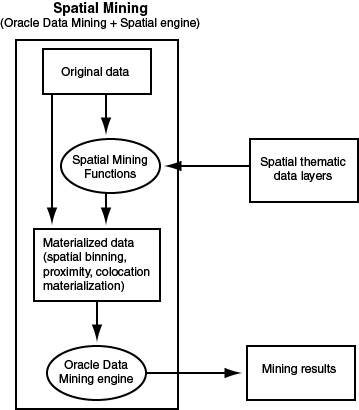9.1 Spatial Information and Data Mining Applications
Oracle Data Mining allows automatic discovery of knowledge from a database. Its techniques include discovering hidden associations between different data attributes, classification of data based on some samples, and clustering to identify intrinsic patterns. Spatial data can be materialized for inclusion in data mining applications.
Thus, Oracle Data Mining might enable you to discover that sales prospects with addresses located in specific areas (neighborhoods, cities, or regions) are more likely to watch a particular television program or to respond favorably to a particular advertising solicitation. (The addresses are geocoded into longitude/latitude points and stored in an Oracle Spatial geometry object.)
In many applications, data at a specific location is influenced by data in the neighborhood. For example, the value of a house is largely determined by the value of other houses in the neighborhood. This phenomenon is called spatial correlation (or, neighborhood influence), and is discussed further in Materializing Spatial Correlation. The spatial analysis and mining features in Oracle Spatial let you exploit spatial correlation by using the location attributes of data items in several ways: for binning (discretizing) data into regions (such as categorizing data into northern, southern, eastern, and western regions), for materializing the influence of neighborhood (such as number of customers within a two-mile radius of each store), and for identifying colocated data items (such as video rental stores and pizza restaurants).
To perform spatial data mining, you materialize spatial predicates and relationships for a set of spatial data using thematic layers. Each layer contains data about a specific kind of spatial data (that is, having a specific "theme"), for example, parks and recreation areas, or demographic income data. The spatial materialization could be performed as a preprocessing step before the application of data mining techniques, or it could be performed as an intermediate step in spatial mining, as shown in Figure 9-1.
Figure 9-1 Spatial Mining and Oracle Data Mining

Description of "Figure 9-1 Spatial Mining and Oracle Data Mining"
Notes on Figure 9-1:
-
The original data, which included spatial and nonspatial data, is processed to produce materialized data.
-
Spatial data in the original data is processed by spatial mining functions to produce materialized data. The processing includes such operations as spatial binning, proximity, and colocation materialization.
-
The Oracle Data Mining engine processes materialized data (spatial and nonspatial) to generate mining results.
The following are examples of the kinds of data mining applications that could benefit from including spatial information in their processing:
-
Business prospecting: Determine if colocation of a business with another franchise (such as colocation of a Pizza Hut restaurant with a Blockbuster video store) might improve its sales.
-
Store prospecting: Find a good store location that is within 50 miles of a major city and inside a state with no sales tax. (Although 50 miles is probably too far to drive to avoid a sales tax, many customers may live near the edge of the 50-mile radius and thus be near the state with no sales tax.)
-
Hospital prospecting: Identify the best locations for opening new hospitals based on the population of patients who live in each neighborhood.
-
Spatial region-based classification or personalization: Determine if southeastern United States customers in a certain age or income category are more likely to prefer "soft" or "hard" rock music.
-
Automobile insurance: Given a customer's home or work location, determine if it is in an area with high or low rates of accident claims or auto thefts.
-
Property analysis: Use colocation rules to find hidden associations between proximity to a highway and either the price of a house or the sales volume of a store.
-
Property assessment: In assessing the value of a house, examine the values of similar houses in a neighborhood, and derive an estimate based on variations and spatial correlation.
Parent topic: Spatial Analysis and Mining